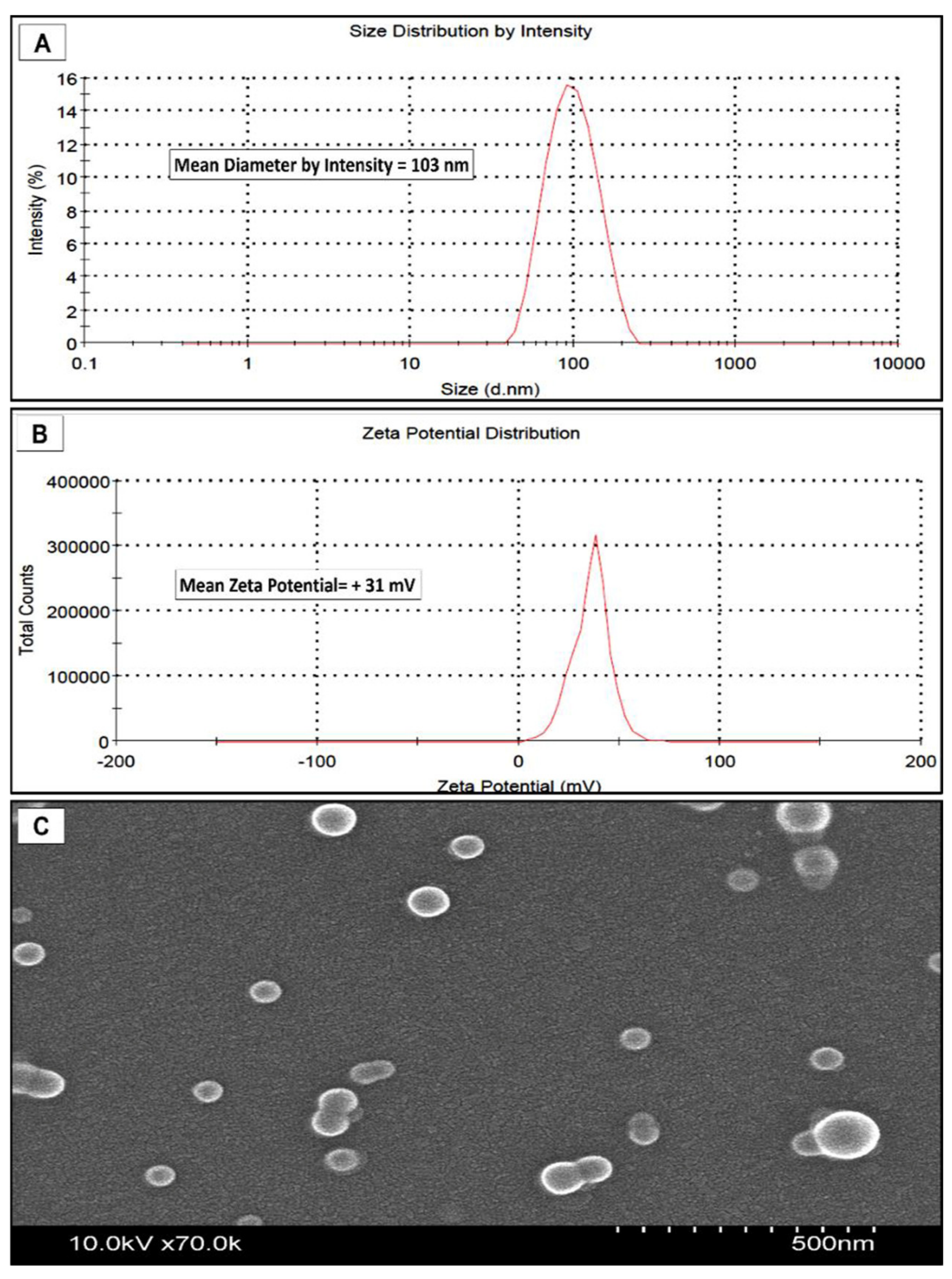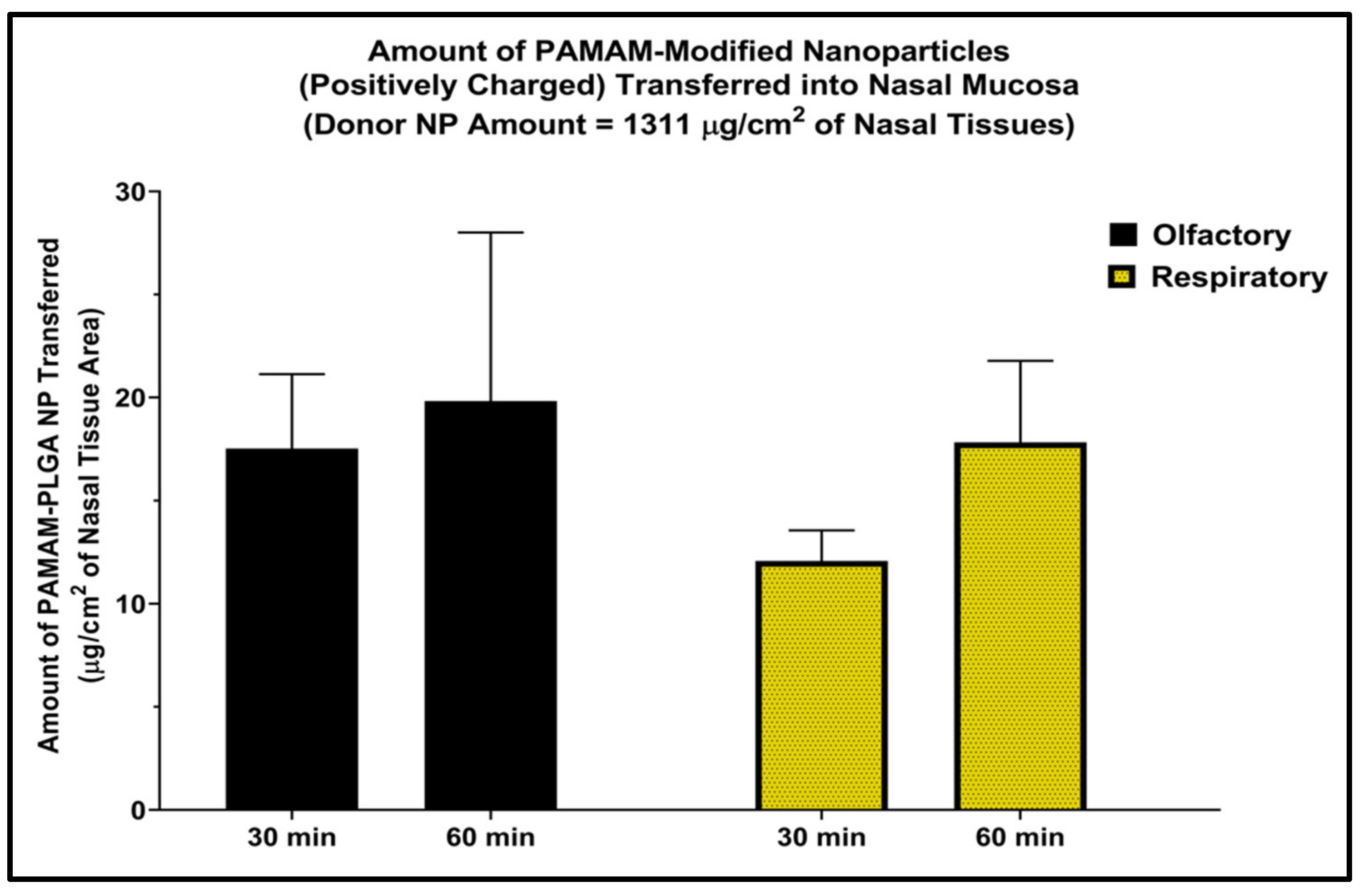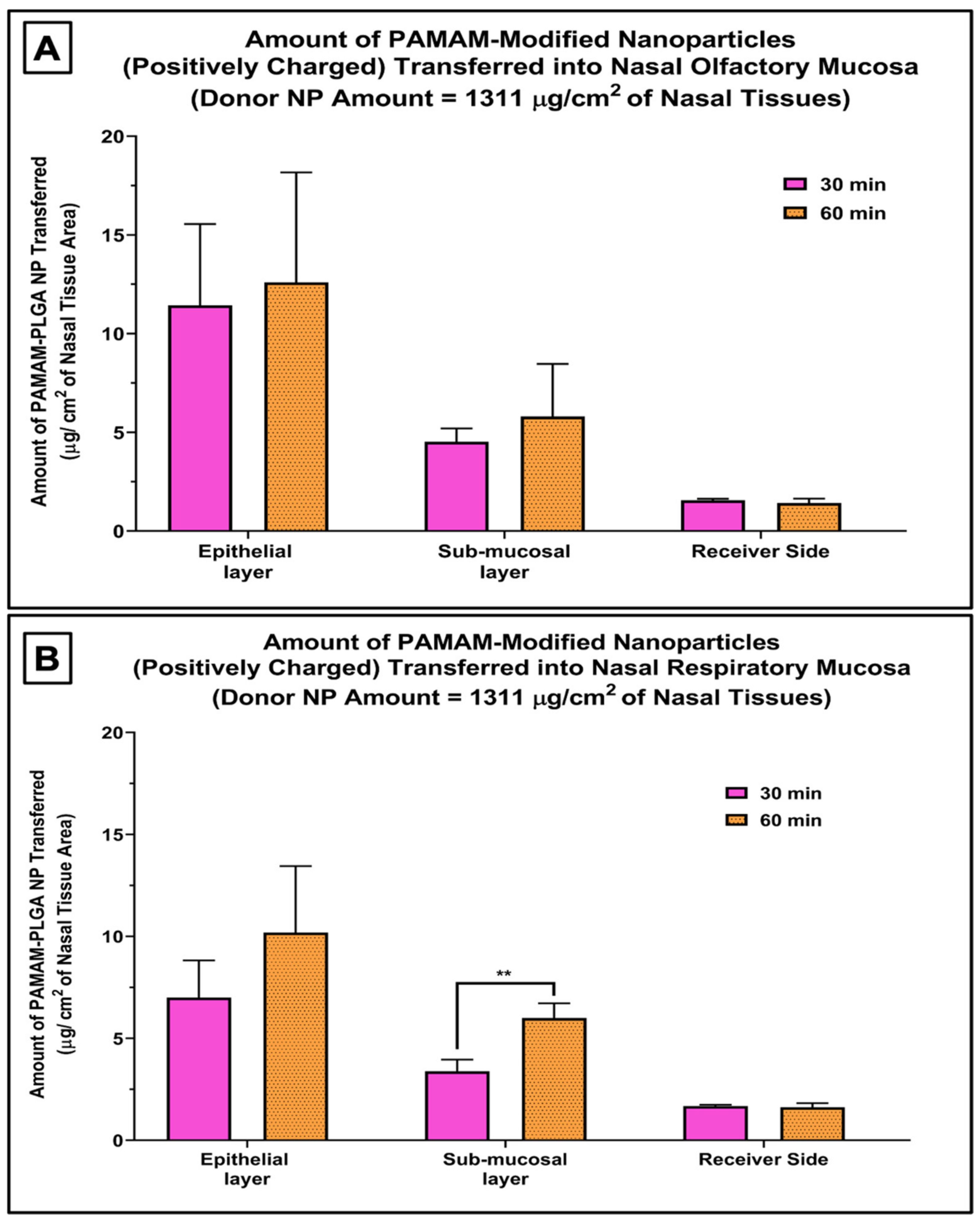Uptake of Cationic PAMAM-PLGA Nanoparticles by the Nasal Mucosa
Abstract
1. Introduction
2. Materials and Methods
2.1. Materials
2.2. Preparation of PLGA Nanoparticles
2.3. Modification of Surface Charge of 60 nm PLGA Nanoparticles
2.4. Characterization of Nanoparticles
2.4.1. Dynamic Light Scattering (DLS)
2.4.2. Scanning Electron Microscopy (SEM)
2.5. Nile Red Loading and Encapsulation Efficiency
2.6. Preparation of Excised Bovine Nasal Tissues
2.7. Nanoparticle Uptake
2.8. Data Analysis
3. Results and Discussion
3.1. Nanoparticle Characterization
3.2. Uptake of Positively Charged PLGA Nanoparticles
3.3. Effect of Surface Charge Modification on Uptake of 60 nm Nanoparticles
4. Conclusions
Author Contributions
Funding
Institutional Review Board Statement
Informed Consent Statement
Data Availability Statement
Conflicts of Interest
References
- Albarki, M. Evaluation of poly D, L Lactic-co-glycolic Acid (PLGA) Nanoparticle Uptake Pathways Across the Nasal Mucosa. Ph.D. Thesis, University of Iowa, Iowa City, IA, USA, 2019. [Google Scholar] [CrossRef]
- Al Khafaji, A.S.; Donovan, M.D. Endocytic Uptake of Solid Lipid Nanoparticles by the Nasal Mucosa. Pharmaceutics 2021, 13, 761. [Google Scholar] [CrossRef] [PubMed]
- Peer, D.; Karp, J.M.; Hong, S.; Farokhzad, O.C.; Margalit, R.; Langer, R. Nanocarriers as an emerging platform for cancer therapy. Nat. Nanotechnol. 2007, 2, 751–760. [Google Scholar] [CrossRef]
- Albanese, A.; Tang, P.S.; Chan, W.C.W. The Effect of Nanoparticle Size, Shape, and Surface Chemistry on Biological Systems. Annu. Rev. Biomed. Eng. 2012, 14, 1–16. [Google Scholar] [CrossRef] [PubMed]
- Du, B.; Yu, M.; Zheng, J. Transport and interactions of nanoparticles in the kidneys. Nat. Rev. Mater. 2018, 3, 358–374. [Google Scholar] [CrossRef]
- Choi, H.S.; Liu, W.; Liu, F.; Nasr, K.; Misra, P.; Bawendi, M.G.; Frangioni, J.V. Design considerations for tumour-targeted nanoparticles. Nat. Nanotechnol. 2009, 5, 42–47. [Google Scholar] [CrossRef] [PubMed]
- Decuzzi, P.; Godin, B.; Tanaka, T.; Lee, S.-Y.; Chiappini, C.; Liu, X.; Ferrari, M. Size and shape effects in the biodistribution of intravascularly injected particles. J. Control. Release 2010, 141, 320–327. [Google Scholar] [CrossRef]
- Bannunah, A.M.; Vllasaliu, D.; Lord, J.; Stolnik, S. Mechanisms of Nanoparticle Internalization and Transport Across an Intestinal Epithelial Cell Model: Effect of Size and Surface Charge. Mol. Pharm. 2014, 11, 4363–4373. [Google Scholar] [CrossRef] [PubMed]
- Clementino, A.R.; Pellegrini, G.; Banella, S.; Colombo, G.; Cantù, L.; Sonvico, F.; Del Favero, E. Structure and Fate of Nanoparticles Designed for the Nasal Delivery of Poorly Soluble Drugs. Mol. Pharm. 2021, 18, 3132–3146. [Google Scholar] [CrossRef] [PubMed]
- Chaikhumwang, P.; Madapong, A.; Saeng-Chuto, K.; Nilubol, D.; Tantituvanont, A. Intranasal delivery of inactivated PRRSV loaded cationic nanoparticles coupled with enterotoxin subunit B induces PRRSV-specific immune responses in pigs. Sci. Rep. 2022, 12, 3725. [Google Scholar] [CrossRef]
- McNeil, S.E. Nanoparticle Therapeutics: A Personal Perspective. Wiley Interdiscip. Rev. Nanomed. Nanobiotechnol. 2009, 1, 264–271. [Google Scholar] [CrossRef]
- Goodman, C.M.; McCusker, C.D.; Yilmaz, A.T.; Rotello, V.M. Toxicity of Gold Nanoparticles Functionalized with Cationic and Anionic Side Chains. Bioconjug. Chem. 2004, 15, 897–900. [Google Scholar] [CrossRef] [PubMed]
- Leroueil, P.R.; Berry, S.A.; Duthie, K.; Han, G.; Rotello, V.M.; McNerny, D.Q.; Baker, J.R., Jr.; Orr, B.G.; Holl, M.M.B. Wide Varieties of Cationic Nanoparticles Induce Defects in Supported Lipid Bilayers. Nano Lett. 2008, 8, 420–424. [Google Scholar] [CrossRef]
- Verma, A.; Uzun, O.; Hu, Y.; Hu, Y.; Han, H.-S.; Watson, N.; Chen, S.; Irvine, D.J.; Stellacci, F. Surface-structure-regulated cell-membrane penetration by monolayer-protected nanoparticles. Nat. Mater. 2008, 7, 588–595. [Google Scholar] [CrossRef] [PubMed]
- Dobrovolskaia, M.A.; McNeil, S.E. Immunological properties of engineered nanomaterials. Nat. Nanotechnol. 2007, 2, 469–478. [Google Scholar] [CrossRef]
- Albarki, M.A.; Donovan, M.D. Bigger or Smaller? Size and Loading Effects on Nanoparticle Uptake Efficiency in the Nasal Mucosa. AAPS PharmSciTech 2020, 21, 1–8. [Google Scholar] [CrossRef]
- Schmidt, M.C.; Simmen, D.; Hilbe, M.; Boderke, P.; Ditzinger, G.; Sandow, J.; Lang, S.; Rubas, W.; Merkle, H.P. Validation of Excised Bovine Nasal Mucosa as in vitro Model to Study Drug Transport and Metabolic Pathways in Nasal Epithelium. J. Pharm. Sci. 2000, 89, 396–407. [Google Scholar] [CrossRef]
- Al Bakri, W.S.H. Characterization of Atrazine Transport Across Nasal Respiratory and Olfactory Mucosa. Master’s Thesis, The University of Iowa, Iowa City, IA, USA, 2014. [Google Scholar] [CrossRef]
- Chen, N. Size and Surface Properties Determining Nanoparticle Uptake and Transport in the Nasal Mucosa. Ph.D. Thesis, The University of Iowa, Iowa City, IA, USA, 2013. [Google Scholar] [CrossRef]
- Mistry, A.; Stolnik, S.; Illum, L. Nose-to-Brain Delivery: Investigation of the Transport of Nanoparticles with Different Surface Characteristics and Sizes in Excised Porcine Olfactory Epithelium. Mol. Pharm. 2015, 12, 2755–2766. [Google Scholar] [CrossRef] [PubMed]
- Intra, J.; Salem, A.K. Fabrication, Characterization and In Vitro Evaluation of poly (D,L-lactide-co-glycolide) Microparticles Loaded with Polyamidoamine-Plasmid DNA Dendriplexes for Applications in non-viral Gene Delivery. J. Pharm. Sci. 2010, 99, 368–384. [Google Scholar] [CrossRef]
- Zhang, X.-Q.; Intra, J.; Salem, A.K. Conjugation of Polyamidoamine Dendrimers on Biodegradable Microparticles for Nonviral Gene Delivery. Bioconjug. Chem. 2007, 18, 2068–2076. [Google Scholar] [CrossRef] [PubMed]
- Surekha, B.; Kommana, N.S.; Dubey, S.K.; Kumar, A.P.; Shukla, R.; Kesharwani, P. PAMAM dendrimer as a talented multifunctional biomimetic nanocarrier for cancer diagnosis and therapy. Colloids Surf. B Biointerfaces 2021, 204, 111837. [Google Scholar] [CrossRef] [PubMed]
- Harper, S.; Pryor, J.; Harper, B. Comparative toxicological assessment of PAMAM and thiophosphoryl dendrimers using embryonic zebrafish. Int. J. Nanomed. 2014, 9, 1947–1956. [Google Scholar] [CrossRef] [PubMed]




| Formulation | Average Diameter (by DLS) (nm) | Polydispersity Index (PDI) | Average Zeta Potential (mV) | Nile Red Loading (µg/mg) |
|---|---|---|---|---|
| PLGA nanoparticles | 60 | 0.15 | −28 | 0.60 |
| PAMAM Modified PLGA nanoparticles | 103 | 0.1 | +31.4 | 0.59 |
Publisher’s Note: MDPI stays neutral with regard to jurisdictional claims in published maps and institutional affiliations. |
© 2022 by the authors. Licensee MDPI, Basel, Switzerland. This article is an open access article distributed under the terms and conditions of the Creative Commons Attribution (CC BY) license (https://creativecommons.org/licenses/by/4.0/).
Share and Cite
Albarki, M.A.; Donovan, M.D. Uptake of Cationic PAMAM-PLGA Nanoparticles by the Nasal Mucosa. Sci. Pharm. 2022, 90, 72. https://doi.org/10.3390/scipharm90040072
Albarki MA, Donovan MD. Uptake of Cationic PAMAM-PLGA Nanoparticles by the Nasal Mucosa. Scientia Pharmaceutica. 2022; 90(4):72. https://doi.org/10.3390/scipharm90040072
Chicago/Turabian StyleAlbarki, Mohammed A., and Maureen D. Donovan. 2022. "Uptake of Cationic PAMAM-PLGA Nanoparticles by the Nasal Mucosa" Scientia Pharmaceutica 90, no. 4: 72. https://doi.org/10.3390/scipharm90040072
APA StyleAlbarki, M. A., & Donovan, M. D. (2022). Uptake of Cationic PAMAM-PLGA Nanoparticles by the Nasal Mucosa. Scientia Pharmaceutica, 90(4), 72. https://doi.org/10.3390/scipharm90040072






